Bohunka Koklesová:
Video, Multimedia, Performance Studio - Tomas Ruller's Studio
O umení a učení.
"No urgency applies to art.
It is not subject to any discipline of the spirit.
Its impulse to create is volition."
Johan Huizinga, 1935
This simple quotation by its wording embodies a truth that runs like a golden thread through the entire spiral of the history of art. Although 20th-century art covers the concept of "production and creation" within the broad formal planes, movements do appear that try to replace the creative principle with a scientific, analytical approach (by swerving off creativity as the only possible approach); ultimately, however, "volition" persists as the overriding idea.

Opening: Jiří Olič, Rector VŠVU Ján Hoffstädter and Tomáš Ruller
The concept carries in its essence an inherent endeavour to ferret out certain formulations, meanings which, from the artist's subjective viewpoint resound not solely in the society. Efforts at formulating percepts received through knowledge and experience constitute the initial stage for the origin of a work of art. "Volition" also carries in it a striking measure of responsibility insofar as potentiality transformed through a work of art means an author's becoming conscious of the importance of his contribution and message to the cultural sphere. The preceding ideas are mutually intertwined with the ancient wisdom "know thyself" or be thyself. The urgency of these attitudes becomes relevant in an especially intense manner in spheres stimulating various creative approaches. According to W. Welsch, if an artist creates his own type of a work of art, he essentially creates his own self. Although numerous contemporary artists dispose of various means of expression, they efface the borders of a manuscript-like character, suppress the evidence of their artistic identity, become themselves as regards their own mode of thinking and judgment of their work. At the same time, it must be observed that art in its various forms conditions an author to overcome himself, to progress through enthusiasm and a certain personal dedication. The value of a work of art is then given by the artist's ability to capture that imperceptible boundary when meanings resound below the surface: they do appear indeed, but are not expressed in the foreground. The compelling resonance of the suspected, the exciting tension of the surface is many times stronger and more effective as regards the creative ideational response than a direct confession. The well-known thesis regarding the "non-existence of pure vision" is a further moment characterizing an artist's perception (and not solely his). The premise of this thesis resides in man's natural disposition to accept every sort of impulses, whether verbal, visual or textual in character that are deposited in the consciousness and subconsciously stimulate man's sensitivity. The visual alphabet of everyone of us spells the range of our ability to see things and phenomena in various associations, planes and dimensions.

Exhibition view: Mařan, Salem, Kolář
One may perceive meanings and become sensitive to codes and ideas hidden below the surface. We must simultaneously admit that even in the age of information technologies our visual capacity is most sharply concentrated on the area in which we move. If we cross the limits of our territory, our discipline, we just dispose of our ability to view things, a fact that need not be negligible in itself, but as regards judging a strange discipline, we may well remain blind. For mutual communication to develop within the framework of a given section or community, it is imperative that certain points of support, perhaps rules, be set up through which our perception and vision of things and phenomena about us would gradually deepen. Their subsequent analysis stimulates "volition" that forms the basis for the origin of a work of art.
Communication and the following discussion are the basic building elements of the educational activity. The above-mentioned ideas about art comprise perhaps a natural part of teaching at art-oriented schools. A student enters the school with an effort to obtain knowledge of art but at the same time, he comes there with a certain stage of education, a scope of vision and world perception. A pedagogue's task is to stimulate the student's desire to improve the knowledge by asking questions in the following discussions, increase the inquisitiveness and above all help the student find and get known his own personality better. It seems that several professions and various means of approaching the student meet together within the educational activity more than anywhere else. We can feel it more intensely exactly in the art-oriented education where it is necessary, in a way, to deal with a student not only by evaluating his results (criticism) but also with his inner world, behaviour and thinking. It is a long-distance process both for a student and a pedagogue. Education of art has its own specific form because it disposes of the personal experience of an artist, his own artistic potential. In some other specializations like science or economy, it is possible for a pedagogue to receive knowledge and pass it to the others. Experience is not essential. A pedagogue at the school of art cannot manage without experience, that is, without his own work. This mutual combination of pedagogy and free work of art deals with an exemplary pattern of symbiosis, an example of communicating vessels serving as a source of information for students and pedagogues. Therefore the process of curriculum formation naturally refers to the basic features of the artist's free work of art.
A video, multimedia and performance studio has been established and led by Tomas Ruller since 1993. The studio has gone through several name transformations but the possibilities of the students' approaches are not limited by the terms comprised in the name of the studio. The name of the studio itself mentions multimedia performance of fine art, freedom of choice and mutual combination of individual artistic styles. Freedom of expression, which must not necessarily relate to art as such, is the main outline of Tomas Ruller's educational activity. However, freedom of expression is not connected with wishes and desires of the students because it would mean resignation to "reflection and extended projection the education necessarily brings". At first sight, the name includes those art forms, which are interconnected. The main emphasis in the education from the point of view of formal work processing is put on video, photography, actions, multimedia utterances and installations.
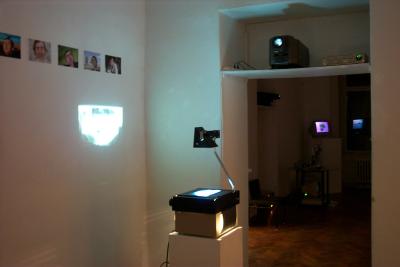
Exhibition view: Zdeněk Lukeš (Burk, Mařan, Kopecký in background)
Studio's profile is established so that individual pieces of art are mutually connected. Boundaries can be crossed in different directions but it is possible to feel a very close cohesion between action, photograph and video. The whole conception of Tomas Ruller's teaching process is clearly graded according to difficulty of the given topics, parallel with the increased teaching of more demanding technical and technological formation processes of students' works. Acquirement of certain processes in the preparation of photography, video and computer animations provide the students with a particular manual for the processing of work with specific regulations. This topic does not relate exclusively with technical parameters but most of all, it offers the basic rules, an alphabet of a certain type of language (video art, performance, post-photography, computer art, etc.). It happens many times that a student tries to express a particular idea in a certain form and he does not know the means of expression of this form. Therefore he becomes unreadable. Conception of Tomas Ruller's studio tries to eliminate these coincidences to a minimal occurrence by a progressive absorption of the fine art alphabet. A study curriculum arranged for a six-year period forms the above-mentioned strong points, which help the communication in the studio to develop and the view and feeling of the students is improved by the study literature references. The subject-matter of a semester or term comprises specifications of possible procedures as regards processing of the topic, a broad take of possibilities reflecting events taking place on the present-day artistic scene, but also reflections on the past. Every term has its own regularly recurring disposition, thus permitting students mutually to confront themselves. In the lower grades themes, very traditional as regards history of art, are assigned - such as still lifes, portraits. However, they are not limited to the past, for they are still topical also today, though in a different terminological modernization. A portrait may be understood as a topic bound in 20th-century art to, e.g. masks of natural nations, Andy Warhol's cult of the stars, or the phenomenon of identity so often proclaimed by numerous artists of modern fine art. Nor does still life lag behind in this sphere insofar as we perceive the principle of modern still lifes in the works of Daniel Spoerri, Mike Kelly, Cindy Sherman or Tonny Cragg. Traditional terms are not linked to archaism, they are merely transformed in their terminological essence. A characteristic feature of the various topical assignments is their firm bond among terms of the same school year. Thus, following completion of the summer term, the relatively firm unit, bound with the assigned topics - mutually related becomes reflected in a feedback. For instance, the topics Open Space (light, shape and space) and Indoors (figure, the body) evoke subjects of a public and private domain, or the Periphery and the Centre. An Object in Motion (mechanical rhythm) and Figure in Motion (biological rhythm) are again antitheses capable to exist independently or in common by their mutual combination through an analysis of mechanized human movements in the society, certain stereotypes which we ultimately remain quite unconscious of. One of the last topics before individual programmes of students of the upper grades is "Action" (construction and destruction) and "Episode" (composition and decomposition) in which positions of contemporary action-art resound most intensively. Performance is the bearing pillar in Tomas Ruller's studio.
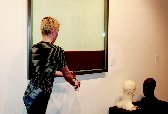
Opening - performance: "In Vino Veritas" Tomáš Székely
Every assignment can be carried out through the positions of action-art. And practically from the very first year the foundations of this artistic form are shaped in the students through their mastering of its manual (sound, music, motion, gesture, dance, speech, language, ritual, cultic objects). Through a gradual mastering of the principles of staging and the scenario in active expression, particularly in its essential temporal-spatial plane, students come to formulate events articulated in a reflection of their personality in the society, or express very intimate confessions - the so-called "personal mythologies". Subsequently, performance becomes especially bound to video which does indeed record the ongoing action, but essentially turns into a carrier of the action and simultaneously also into a work standing in its own right in the form of video-performance. The positions of the various actions in the recording may be bound to a photograph or a computer where these combinations again become distinctive entities. Installations of ritual objects constitute a natural part of the studio's presentation.
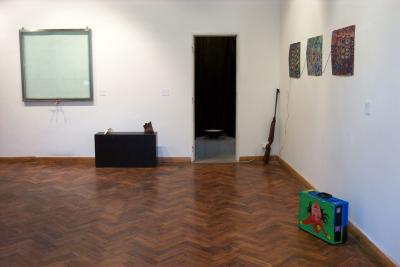
Exhibition view: Székely, Železný, Šesták, Karpíšek
Action-art, particularly through positions of body-art, helps to involve certain extreme situations of the human existence when man reaches the absolute limits of his physical and mental capacities. At this stage a certain moral responsibility for the student becomes incumbent on the teacher. In such a case, the latter must inevitably transfer himself into the position of a psychologist and estimate beforehand the student's abilities. Yet, this notwithstanding, here is a path moving on the fringe of freedom and responsibility.
A natural part and parcel of teaching In Tomas Ruller's studio is a complex presentation of students' works for the public at large. Accumulation, documentation (through recording or textual formulation) and a permanent supplementation of new data from students' practice appear on the school webside. Students' individual profiles on the internet are processed so as to be both lucid and comprehensible, but simultaneously that they also characterize their creative efforts.
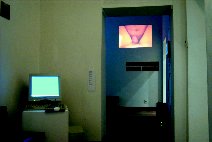
Exhibition view: www site, Slezáková, Nerad
About Art, Identity and Existence.
Problems that in their very denotation resound with their exacting nature and urgency are relatively widely represented in students' works. Existence and identity are reciprocally related terms. The bearing means of expression for students' ideational registering of terms is primarily video-art. Identity as such points to the variability of a given person and this not so much from her external aspect, as rather from her inner characteristic as a unique subject. "Type and role" accompany man throughout his existence and this combination is partially perceived and seen by female students. A part of the video-works done by students of this school touch on the boundaries of gender studies. Several of the authors formulate the feminine view through the principle of a symbolic mirror. By projecting their own private world on the film reel they lay bare positions of their own identity. Their own episodes, recollections, memories are encoded in several of the works. The range of these positions extends from a woman's regular intimate rituals in which the phenomenon of the body and corporeality resounds (Sona Sebestova, Jozefina Slezakova, Petronela Tancekova), up to a characterization of women's behaviour in their own community or society (Svetlana Kuliskova, Jennifer de Felice). The significance of these works primarily resides in an articulation of direct and unique female experiencings, feelings surveyed in the history of art by the male race.
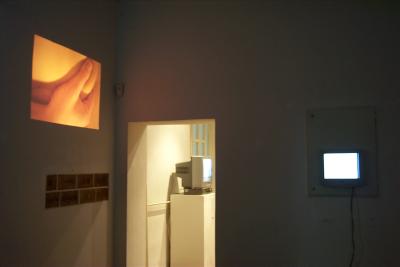
Exhibition view: Slezáková, Women's video sampler, Nerad
Elements of existentialism are also contained in works of video-performance that include recordings of current life, everyday rituals interspersed with fantastic metaphors of dream-like visions of a subconscious being. The contrast between the real and the surreal evokes more effectively the principles of existence (David Burk).
Several of the works by students of this school carry an existential legend or allusion. Video-works formulate the problem of our own existence in the society through an immersion into sociological investigation. Through fleeting portraits of anonymous people (Nadja Slovakova, Jan Mikota), or freelance reportages done in the streets of the town (Jozefina Slezakova, Vladimir Vaca) these works investigateM not only certain stereotypes ingrained in people, their callousness in our present dehumanized world, but above all, a reflection of the state of our society (Czech and Slovak).

Exhibition view: Symon, Slovak, Kulíšková
From the aspect of the response value, video-works evoking the movement of road-movies (Zuzana Ruzickova, Vladimir Zelezny) represent a somewhat freer manifestation that vibrates with a positive feeling from life. The grassroots of this artistic expression may be looked for in the literary pattern "On the Road" by Jack Kerouc or in the photographic cycle "The Americans" by Robert Frank. That is a specific artistic plane fragmentarily capturing feelings as viewed from a car on the road across the countryside or through the town. Road-movie is linked to photography, video and film, but at first presents certain life style.
About Art and Action
A unifying creative expression of teaching in Tomas Ruller's studio is primarily performance in all its visual planes. It is the active element in the studio's various contracts and is simultaneously combined with photographic recording or the video. Very often we may speak of video performance. From the aspect of topic, several of the works reflect issues dealt with in the preceding chapter. Among the most serious works probably are those of performance that constitute a certain self-reflection of the student.

Opening - performance: KRAJ.I.NA.TO of Petr Šesták
The author has to get even innerly with his abilities, his own self. Such are for the most part works bordering on body-art where the student has to rely on his physical and mental dispositions in the company of his camera. Events often take place out in the open and work with symbols for finding one's way in the moment, e.g. of one's own going astray, whereby, making use of metaphors, they formulate theses of transformations at certain life stages (Jakub Deml, Marek Maran). Extreme situations often take place in strongly stressful junctures in which the author persists for some time. (Pavel Prazak).
The photographed actions frequently contain analyses of human motions starting from a certain lethargy, up to states of ecstasy that reflect the performer's mental state, his emotions (Vladimir Vaca, David Burk).
A relatively extensive part of the studio's work consists of modern celebrations which conform to the scenario worked out beforehand. A typical trait of these actions is the staging of the entire undertaking, involving a larger number of invited persons, coulisses, ritual objects. The celebrations are unusually playful attitudes towards such themes as scouting, expeditions of ancient Egypt or motives of the Far West (Matej Kolar). Celebrations are an expression of the joy of life, just as they used to be throughout the history of mankind.

Opening - literary music performance: Jennifer de Felice,
Zdeněk Lukeš, Pavel Pražák
Self-portraying positions are situated in several performances. Frequent positions in projects are reflections on everyday situations, regular civic rituals, but also students' chance encounters. Works represent some sort of a recording, possibly a diary of one or several preordained days, where the visual outcome of the event is not known beforehand (Prokop Holoubek, Vladimr Vaca, Jozefina Slezkova, Svetlana Kuliskova). Actions reckon with elements of chance.
Frequent visual signs of actions are, as a rule, simulated technical errors on the monitor, centred on man's absurd behaviour as two equivalent parallel planes reciprocally characterizing one another (Vladimr Vaca).
Within the scope of pedagogical practice in the studio, attention is focused on knowledge of rituals of natural nations. These facets are often reflected in installations of ritual objects by several of the students (Jan Prosek).

Exhibition view: Prošek, Dvořák, Kočišová
About Art and Mass Media
Photographs, installations, objects in works by students are connected with the visual position of mass media. Through the expedients of advertising, television, film, radio, term works articulate ideas mythologizing a certain status of man in the society which, according to Umberto Eco, is based on a forced acceleration of production and consumption. The above means of expression are used to combine artistic formulations guaranteeing a broader socio-cultural impact. However, a discussion on the plane of two contradictory attitudes points, often with humour and irony, to the absorption of deep-seated norms in the society, to stereotypes often referred to.
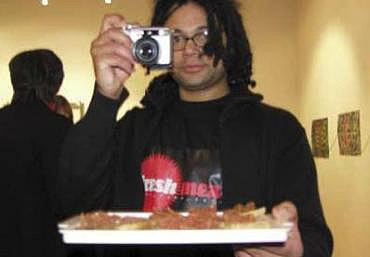
Opening - performance: "Fresh Meat" David K. Tieku
Students' works often contain contrasts based on the principles of spiritual values of Eastern cultures - mandala in conjunction with cultic symbols of our consumer mode of life - fast-food (Jiri Havlicek), figures of Christ giving out blessings located on theÍ internet, cult of Hollywood stars, models with the "down-to-earth" quality of our own existence (Milan Kincl), the eviscerated and emptied broiler products with the subsequently applied artistic expressions (Petronela Tancekova), or promotion posters confronting graphic designs and art (David Tieku).
Television is a phenomenon which probably most intensively attacks our senses, dulls our perception and sensitivity. Preordained stencils of telecasting times dose out and repeat programmes and commercials to the viewers in certain stereotypes reminiscent of a never-ending carousel. This aspect of mass media is reflected in the works of students of this school. Rather frequent are recyclings of old soapy films in which the selected episode is positioned in a steadily accelerating loop on the film reel. The frequency is a parallel to the frequency of alternations of television attacks (Zdenek Mezihorak, Filip Cenek).
The reverse of television is cinematography which, according to Barbara Kruger, focuses on certain events and at the same time uncovers relations to fine art, photography, video and literature. A certain regressive approach may be the fact that these bonds are pointed out through photography quoting pictures of a film in dislocated visual transformations (Vit Kraus).

Exhibition view: Kraus, Mezihorák, Havlíček
Students or the oncoming generation of artists reach out quite naturally after means of expression used by mass media. Occasionally, when face to face with works of this type, we experience their artistic fusion with these phenomena through a natural usage of the language of these media. The means of visual aggressiveness of mass media are confronted in the various works with humour and exaggeration. That is something similar to the situation when someone strenuously strives to achieve his end without any self-reflection and we are the witness following, as if from a bird's eye view, a struggle with wind-mills for, in the final analysis of things, there remains practically no value whatsoever. The visual angle chosen by students does not condemn mass media, but rather approaches them with the feeling of a certain compromise with this phenomenon of our times.
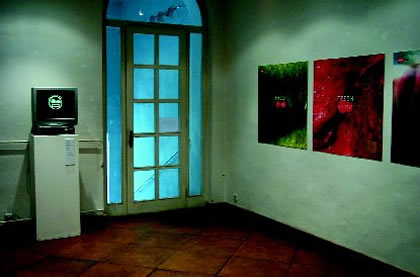
Exhibition in foyer: Women's video sampler and installation by D. K. Tieku
Students and graduates of Tomas Ruller's studio considerably differ by their approach to the artistic expression in both topic and mode of processing. Although the students are unified through the topic assigned and the technique, the ultimate choice fosters a student's individual growth.

Opening: B. Koklesová, T. Ruller
A catalogue compiled on the occasion of an exhibition at the Medium Gallery at the Academy of Applied Arts in Bratislava, constitutes a cross-section of the teacher's pedagogical activity. Were I to characterize the studio's expression from a complex point of view, then it is first and foremost a certain positivism. To my view, the works often process serious topics, but many of them breathe out humour, keen observations of life, a certain relaxation, freedom proper to the students' age. Many of the works are strongly bound to the life of individual students, their hobbies, joys, their family rhythms and attitudes.
I am of the opinion that people ought to do things appropriate to their's age.
Bohunka Koklesová 2002
